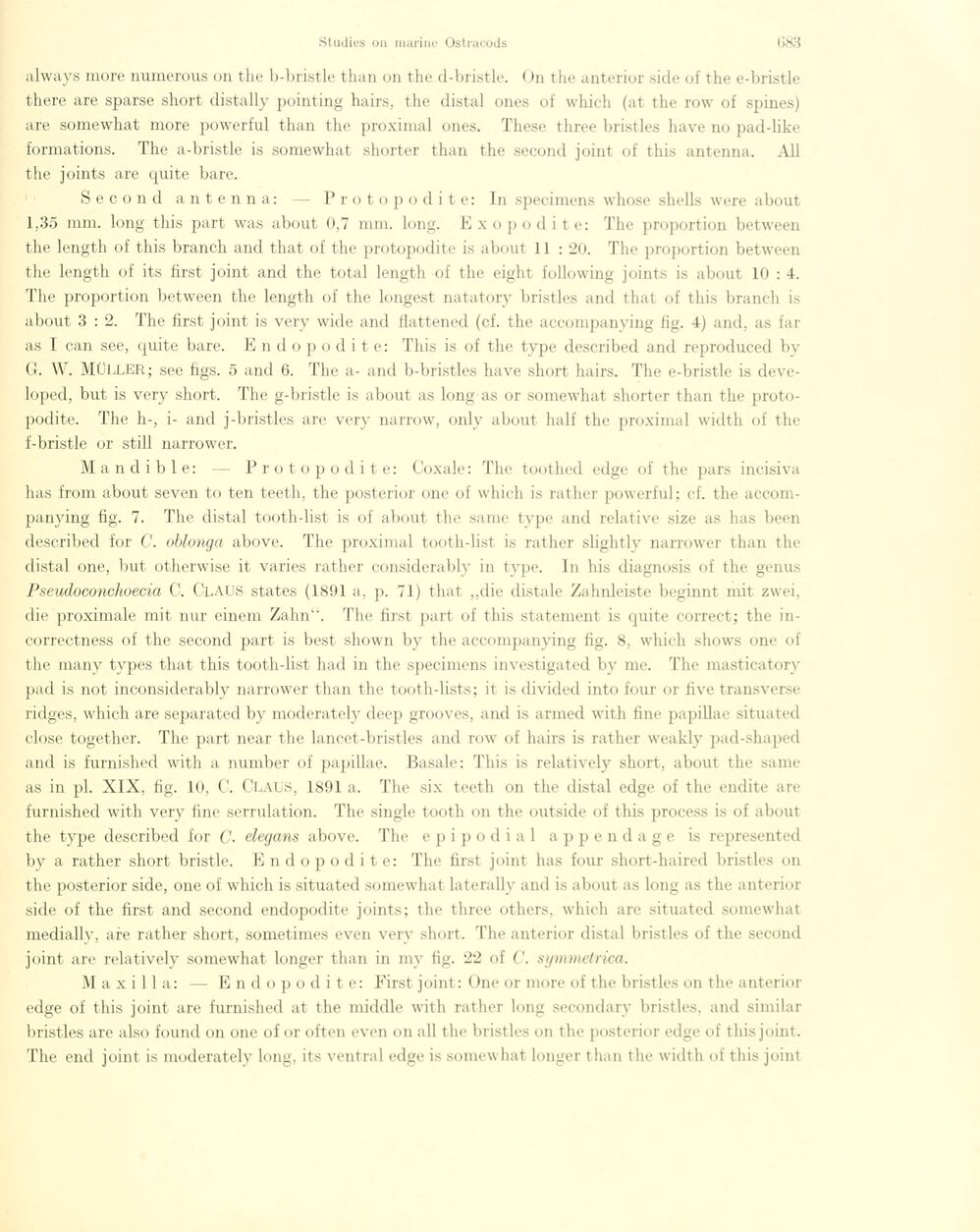
Full resolution (JPEG) - On this page / på denna sida - Sidor ...

<< prev. page << föreg. sida << >> nästa sida >> next page >>
Below is the raw OCR text
from the above scanned image.
Do you see an error? Proofread the page now!
Här nedan syns maskintolkade texten från faksimilbilden ovan.
Ser du något fel? Korrekturläs sidan nu!
This page has never been proofread. / Denna sida har aldrig korrekturlästs.
always more numerous on the b-bristle than on the d-bristle. On the anterior side of the e-bristle
there are sparse short distally pointing hairs, the distal ones of which (at the row of spines)
are somewhat more powerful than the proximal ones. These three bristles have no pad-like
formations. The a-bristle is somewhat shorter than the second joint of this antenna. All
the joints are quite bare.
Second antenna: — Protopo dite: In specimens wliose shells were about
1,35 mm. long this part was about 0,7 mm. long. Exopodite: The proportion between
the length of this branch and that of the protopodite is about 11 : 20. The proportion between
the length of its first joint and the total length of the eight following joints is about 10 : 4.
The proportion between the length of the longest natatory bristles and that of this branch is
about 3 : 2. The first joint is very wide and flattened (cf. the accompanying fig. 4) and, as far
as I can see, quite bare. Endo p odit e: This is of the type described and reproduced by
G. W. MÜLLER; see figs. 5 and 6. The a- and b-bristles have short hairs. The e-bristle is
deve-loped, but is very short. The g-bristle is about as long as or somewhat shorter than the
proto-podite. The h-, i- and j-bristles are very narrow, only about half the proximal width of the
f-bristle or still narrower.
Man dible: — Pro top od i te: Coxale: The toothed edge of the pars incisiva
has from about seven to ten teetli, the posterior one of which is rather powerful; cf. the
accompanying fig. 7. The distal tooth-list is of about the same type and relative size as has been
described for C. oblonga above. The proximal tooth-list is rather slightly narrower than the
distal one, but otherwise it varies rather considerably in type. In his diagnosis of the genus
Pseudoconchoecia C. Claus states (1891 a, p. 71) that „die distale Zahnleiste beginnt mit zwei,
die proximale mit nur einem Zahn“. The first part of this statement is quite correct; the
in-correctness of the second part is best shown by the accompanying fig. 8, which shows one of
the many types that this tooth-list had in the specimens investigated by me. The masticatory
pad is not inconsiderably narrower than the tooth-lists; it is divided into four or five transverse,
ridges, which are separated by moderately deep grooves, and is armed with fine papillae situated
close together. The part near the lancet-bristles and row of hairs is rather weakly pad-shaped
and is furnished with a number of papillae. Basale: This is relatively short, about the same
as in pl. XIX, fig. 10, C. CLAUS, 1891 a. The six teeth on the distal edge of the endite are
furnished with very fine serrulation. The single tooth on the outside of this process is of about
the type described for C■ elegans above. The e p i p o d i a 1 a p p e n d a g e is represented
by a rather short bristle. Endopodite: The first joint has four short-haired bristles on
the posterior side, one of which is situated somewhat laterally and is about as long as the anterior
side of the first and second endopodite joints; the three others, which arc situated somewhat
medially, are rather short, sometimes even verv short. The anterior distal bristles of the second
joint are relatively somewhat longer than in my fig. 22 of C. symmetrica.
Maxilla: — Endopodite: First joint: One or more of the bristles on the anterior
edge of this joint are furnished at the middle with rather long secondary bristles, and similar
bristles are also formd on one of or offen even on all the bristles on the posterior edge of this joint.
The end joint is moderately long, its ventral edge is somewhat longer than the width of this joint
<< prev. page << föreg. sida << >> nästa sida >> next page >>